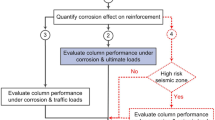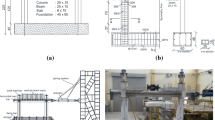Abstract
When an under-reinforced concrete beam structure has been loaded to the point where reinforcing steel on the tension side has yielded, it is deemed to have structurally failed and the full load capacity and stiffness can no longer be developed. When unloaded from the point of failure, the residual stiffness of the structure is difficult to estimate. There is a need to establish the serviceability of the structure and ultimately establish the levels of further loading that can be sustained before total collapse. In this paper we present a method for assessing residual stiffness of such a “failed” reinforced concrete structure, through the application of dynamic testing and finite element (FE) model updating. In an experimental study, failed zones in a beam structure were simulated in a FE model. Through a procedure of sensitivity-based updating using the measured modal properties, the stiffness distribution along the failed beam structure was identified.
Similar content being viewed by others
Abbreviations
- D i :
-
damage index
- E :
-
Young's modulus
- f :
-
vector of frequencies
- f :
-
frequency
- H :
-
frequency response function
- I :
-
second moment of beam cross-section
- i :
-
complex number
- MAC :
-
modal assurance criterion
- p :
-
vector of structural parameters
- r :
-
vector of structural responses
- [S]:
-
sensitivity matrix
- Δ:
-
difference
- ϕ:
-
vector of mode shapes
- ω:
-
circular frequency
- a :
-
analysis
- c :
-
concrete
- e :
-
experiment
- f :
-
frequency
- m :
-
measurement or mid-span
- n :
-
nth iteration
- i :
-
ith response
- j :
-
jth parameter
- u :
-
updated
- o :
-
original
- p :
-
excitation point
- q :
-
measurement point
References
Nawy, E.G., “Reinforced Concrete, 2nd edition, Prentice-Hall, Englewood Cliffs, NJ (1990).
Mottershead, J.E. andFriswell, M.I., “Model Updating in Structural Dynamics: A Survey,”J. Sound Vib.,167 (2),347–375 (1993).
Doebling, S.W., Farrar, C.R., andPrime, M.B., “A Summary Review of Vibration-based Damage Identification Methods,”Shock Vib. Digest,30 (2),9–105 (1998).
Brownjohn, J.M.W. andXia, P.Q., “Finite Element Model Updating of a Damaged Structure,”Proc. 17th Int. Modal Analysis Conference, SEM, Kissimmee, FL, Vol.I, 457–462 (1999).
Brownjohn, J.M.W. andXia, P.Q., “Dynamic Assessment of Curved Cable-stayed Bridge by Model Updating,”J. Struct. Eng., ASCE,126 (2),252–260 (2000).
Brownjohn, J.M.W., Xia, P.Q., Hao, H., andXia, Y., “Civil Structure Condition Assessment by FE Model Updating: Methodology and Case Studies,”Finite Elements in Analysis and Design,37 (10),761–775 (2001).
Fritzen, C.P. and Bohle, K., “Model-based Health Monitoring of Structures—Application to the 140-highway-bridge,” Proc. Identification in Engineering System, Swansea, UK, 492–505 (1999).
http://www.bwk.kuleuven.ac.be/bwm/pub_pro.htm
Ewins, D.J., Modal Testing: Theory and Practice, Research Studies Press Ltd, Wiley, New York (1984).
Godfrey, K., Perturbation Signals for System Identification, Prentice-Hall, Englewood Cliffs, NJ (1993).
FEMtools User Manual, Version 1.4, Dynamic Design Solutions, Belgium (1998).
Allemang, R.J. and Brown, D.L., “A Correlation Coefficient for Modal Vector Analysis,” Proc. 1st Int. Modal Analysis Conference, SEM, Orlando, Florida, 110–116 (1982).
Brownjohn, J.M.W., Pan, T.C., and Deng, X.Y., “Macro-updating of Finite Element Modelling for Core Systems of Tall Buildings,” Proc. 14th Engineering Mechanics Conferences ASCE, Texas (2000).
Felber, A.J. andCantieni, R., “Advances in Ambient Vibration Testing: Ganter Bridge, Switzerland,”Struct. Eng. Int.,6 (3),187–190 (1996).
Hearn, G., “Condition Data and Bridge Management System,”Struct. Eng. Int., IABSE,8 (3),221–225 (1998).
Aktan, A.E., Farhey, D.F., Brown, D.L., Dalal, V., Helmicki, A.J., Hunt, V.J., andShelley, S.J., “Condition Assessment for Bridge Management,”J. Infrastructure Syst., ASCE,2 (3),108–117 (1996).
Author information
Authors and Affiliations
Rights and permissions
About this article
Cite this article
Xia, PQ., Brownjohn, J.M.W. Residual stiffness assessment of structurally failed reinforced concrete structure by dynamic testing and finite element model updating. Experimental Mechanics 43, 372–378 (2003). https://doi.org/10.1007/BF02411341
Received:
Revised:
Issue Date:
DOI: https://doi.org/10.1007/BF02411341




